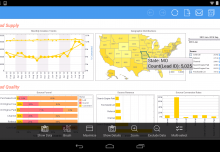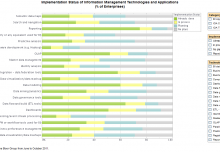Business intelligence platforms are used to collect and analyze data with charts, metrics, and graphs to ultimately determine what parts of your business strategy are working and what parts need improvement. When it comes to sales data analysis, there are lots of moving parts from the moment a marketer determines a lead source is worthy of being pursued to the moment they close the deal.
This means that there’s also lots of room for mistakes to be made if data collection isn’t being prioritized and organized correctly. Here, we’re going to break down four ways to improve your sales approaches with business intelligence.
1. Identify strong- and low-performing marketing channels
When sales reporting software gathers data, it’s gathering everything you want it to, in an effort to determine what direction your company is heading in as well as identifying patterns based on the key performance indicators (KPIs), like total revenue and lead conversions, it gathers. In order to have a successful sales strategy where conversions and revenue is up, there has to be a strong source of leads from the marketing channels.
Business intelligence solutions come into play by identifying strong- and low-performing marketing channels based on either traffic, click-thru rates from ads, bounce rates, pages per session, or likes and shares on social media, and then organizing that data by turning them into graphs, charts, or reports. When your organization identifies strengths and weaknesses in your marketing channels and user behaviors, you can optimize your marketing and sales strategies to their fullest potential to scale on high performing channels, and optimize/eliminate lower performing ones.
2. In-depth Sales Funnel Analysis
One of the visual elements that business intelligence can offer companies is an interactive sales funnel, which emphasizes the importance of bringing in qualified leads to the sales team, the speed of which the leads are worked, and the ultimate outcomes of the leads. The sales data analysis gathered would ideally help you determine which leads are most likely to go through the funnel and complete the buyer’s journey.
People are visual learners, and visual aids are extremely helpful when painting a larger picture of the entire sales process. Companies gather tons of data on a daily basis, meaning there’s not enough man-power to collect it, organize it, analyze it, and generate a report without any help. With powerful BI software, organizations can take all of that data and create a sales funnel that is up-to-date. Using outdated data can have a negative effect on the buyer’s journey and significantly affect the bottom line.
3. Compile metrics into a dynamic sales metrics dashboard
Metrics, or KPIs, can also play an invaluable role in your sales approach. When implementing business intelligence software, all the data your organization has accumulated over the years can be turned into reports, patterns, and forecasts that can be used to improve your sales strategy. BI software can take that data and turn it into a dynamic sales dashboard so agents can easily see conversion rates, total revenue, where certain leads are stuck in the funnel, cost of sales, and any other KPIs that are relevant to your process.
The key is to only use metrics that are relevant to your needs. Too much data can be a bad, overwhelming thing for anyone who doesn’t know how to manage it properly. Again, this is why business intelligence exists. It’s there to help a sales agent or manager determine what data should be looked at and how that data can optimize your sales strategy.
4. Predictive analytics help improve future sales strategies
Predictive analytics typically involves machine learning technology, which helps make sense of all the data BI software gathers by detecting patterns undetectable by agents on their own. It’s good for companies to be able to adopt software that captures and organizes data to be turned into reports, but for people who aren’t capable of figuring out what direction their sales approach is heading in, predictive analytics gets rid of the guesswork.
Predictive analytics is playing a much bigger role in software aside from business intelligence as well, and for good reason. The more you use AI, the more useful it becomes. This is important for the sales strategy because it will not just detect patterns but use that data to show your sales team how it can improve those numbers or identify when potential problems are arising. The easier it is to predict how a sales process or buyer’s journey is going to play out based on past experiences, the more likely it will be that more effective — and repeatable — strategies will develop.
The Final Word
Regardless of the size of your organization, it’s going to be pulling in tons of data that no team would be capable of gathering, organizing, and analyzing in a normal amount of time. There’s too much too look at, which often leads to what-would-be-obvious issues being overlooked without much thought. If you run your sales strategies based on bad data, it’s already too late and your bottom line could be seriously affected.
Business intelligence comes into play by not just gathering and organizing data, but by turning it into meaningful, visual reports, charts, graphs, and forecasts. All of these are great for sales teams who need as much context as they can so they can turn leads from the marketing team into customers. Business intelligence can help organizations identify marketing channels for higher quality leads, offer an in-depth analysis of the sales funnel, turn raw numbers into metrics, and implement predictive analytics so you can optimize your sales efforts for the future.
Without any kind of business intelligence, whether you’re implementing BI software or simply making a conscientious effort to gather and organize data with other kinds of software, you’re leaving yourself at a serious disadvantage.
About the Author:
Reuben Yonatan is the CEO @ GetVoIP, a leading VoIP systems comparison guide that connects shoppers with relevant providers.








